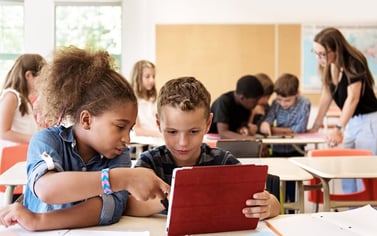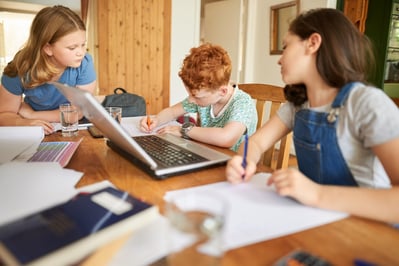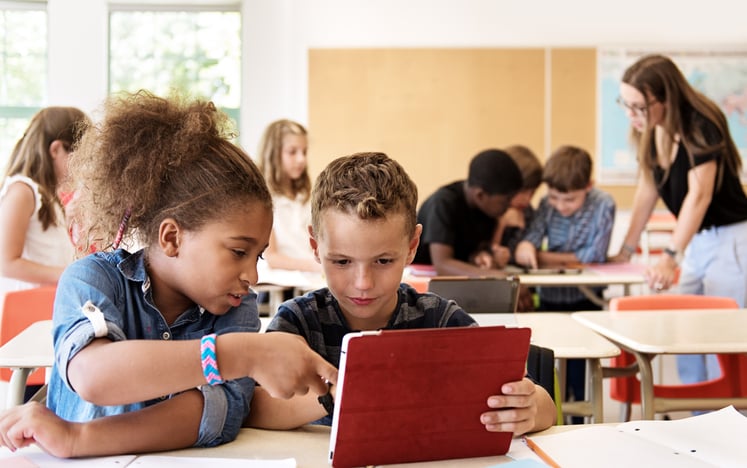Using Peers to Support Autistic Children in the Classroom
Could Peers Be the Solution to Support Autistic Children in the Classroom?
“Put a para with the student” seems to be a quick solution that many school teams jump to when looking for ways to support autistic students. While there are some positives to adult support—including more frequent reinforcement opportunities, constant supervision, and individualized academic modifications—there are some big hurdles to this type of support as well. To start with, paraprofessionals are typically not coming out of the woodwork in a school building. Finding enough staff, training those student-specific interventions, and then retaining those skilled professionals is an ongoing process in the school system.
 Aside from actually finding staff to support students, classmates and teachers may develop a negative perception of the autistic student. This may not be intentional, but sometimes those autistic children are left out of more inclusive opportunities because they are perceived to already have a “partner”, or that the student does not want additional interactions. Furthermore, children do not interact the same way with one another when an adult is present; therefore, the autistic child can be excluded from naturally occurring interactions which can inhibit an oftentimes already stunted social repertoire. So if putting an adult with the struggling student is not the best solution, what other options are there?
Aside from actually finding staff to support students, classmates and teachers may develop a negative perception of the autistic student. This may not be intentional, but sometimes those autistic children are left out of more inclusive opportunities because they are perceived to already have a “partner”, or that the student does not want additional interactions. Furthermore, children do not interact the same way with one another when an adult is present; therefore, the autistic child can be excluded from naturally occurring interactions which can inhibit an oftentimes already stunted social repertoire. So if putting an adult with the struggling student is not the best solution, what other options are there?
It takes a village to teach autistic students, but usually, we only think of adults as making up that support community. Research continues to show that not only do autistic students respond better to interventions that are modeled by same-age neurotypical peers, but it also has positive benefits for those peers by increasing their empathy, advocacy, and leadership skills. Additionally, a community of students supporting their autistic classmates increases inclusivity and normalizes diversity which can greatly impact the community’s emotional well-being.
So great, we plan to use peers to help autistic students. What now? Simply “sticking” a neurotypical peer with an autistic student may not yield the intended results because those peers may not have been exposed to autistic people and are likely not equipped to respond to the academic or social needs that the autistic student requires. Providing peer training sessions can be a wonderful way to help inform and educate classmates about disabilities as a whole, while also allowing them to understand specific interventions and tactics for helping address the autistic student's needs.
Peer Training Sessions
While “peer training sessions” may sound fancy, all it means is teaching, practicing, and giving feedback to the selected peers so that they can effectively help teach the identified student. These peers can act as models by demonstrating the desired behavior or they could act in more of a teacher role by being peer mentors. As a general guideline, these training sessions should occur at minimum once a week for at least 15 minutes depending on the age of the student and the complexity of the skill that they are helping teach the student. The initial training should involve the teacher modeling how to use the intervention. So, if the teacher is using a Language Builder picture card of a banana to have the autistic student match a 3-D banana, the teacher should model that prompting sequence with the actual materials so that the peer can act as a mentor to teach the skill. After the teacher models, next comes guided practice.
 As the peer mentor practices “being the teacher,” the teacher should provide positive feedback and give suggestions or remodel as necessary. It is also a good idea to provide suggestions for what to do if the identified student has an incorrect response. Data should also be a driving force when making decisions; so be sure to have a very simple-to-use data sheet that the peer could use and train them by modeling, practicing, and giving feedback. This data should be a very simple “yes or no” type system that the student can very easily use during the session.
As the peer mentor practices “being the teacher,” the teacher should provide positive feedback and give suggestions or remodel as necessary. It is also a good idea to provide suggestions for what to do if the identified student has an incorrect response. Data should also be a driving force when making decisions; so be sure to have a very simple-to-use data sheet that the peer could use and train them by modeling, practicing, and giving feedback. This data should be a very simple “yes or no” type system that the student can very easily use during the session.
Once the peer is trained, observe the student with the identified student during their first several sessions to help as needed. After that, follow-up peer training sessions can be to check in on progress and troubleshoot any issues. As a guideline, try to continue to have weekly training sessions with the peer mentors for the first 6 weeks and then training can be changed to monthly or quarterly as needed.
Application at Home or Work
Peer mentors or models do not have to be limited to a school setting. The same principles can be applied to life skills and vocational skills in the home or community. Research continues to show that social narratives through pictures, videos, or in real-time are incredibly effective in skill acquisition for autistic children. If your child is struggling with a bedtime routine and you are not able to film or photograph them being successful in any part of the sequence, consider using a peer like their sibling, neighbor, or cousin if they are willing to help.
For academic skills, STAGES® Learning has recently developed the ARIS® Academic Readiness Intervention System that helps apply some of these early language concepts that are incredibly user-friendly and could similarly be modeled or even implemented by a sibling, cousin, or neighbor if the adult is willing to have regular training sessions with the peer mentors.
Begin With the End in Mind

When using a peer-mediated intervention, it’s important to begin with the end in mind. Too often, autistic students can demonstrate a skill only with this one person or only during speech therapy, but they aren’t able to generalize it to different settings, people, or circumstances. Once your identified student has shown success in demonstrating a skill, you should consider implementing the same sequence in another setting with the same peer and then train a different peer until the student can fluently access the skill across settings and individuals.
It takes a village to help support autistic students. Hopefully, by enlisting peers into that village, you will be able to see positive outcomes for your students and the greater school community by building a more caring, more inclusive culture.
References:
“Peer-Mediated Instruction and Intervention.” National Professional Development Center on ASD, 2015, pp. 1–30. Autism Focused Intervention Resources & Modules, https://afirm.fpg.unc.edu/sites/afirm.fpg.unc.edu/files/imce/resources/PMII EBP Brief Packet.pdf.
Shafer, M. S., Egel, A. L., & Neef, N. A. (1984). Training mildly handicapped peers to facilitate changes in the social interaction skills of autistic children. Journal of Applied Behavior Analysis, 17(4), 461-476.
Swaim, K. F., & Morgan, S. B. (2001). Children’s attitudes and behavioral intentions toward a peer with autistic behaviors: Does a brief educational intervention will have an effect? Journal of Autism and Developmental Disorders, 31(2), 195-205.
Twemlow, S. W., Fonagy, P., Sacco, F.C., Gies, M. L., Evans, R., & Ewbank, R. (2001). Creating a peaceful school learning environment: A controlled study of an elementary school intervention to reduce violence. American Journal of Psychiatry, 158, 808-810.
Dunn, Michelle A. S.O.S. Social Skills in Our Schools: a Social Skills Program for Children with Pervasive Developmental Disorders, Including High-Functioning Autism and Asperger Syndrome, and Their Typical Peers. Autism Asperger Pub., 2006.

Frankie Kietzman, Ed.S.
Frankie Kietzman is a Sales Development Associate for STAGES Learning with experience teaching as an elementary teacher, self-contained autism teacher for elementary and secondary students, autism specialist and coach for teachers dealing with challenging behaviors. Frankie’s passion for supporting children and adults with autism originates from growing up with her brother who is deaf and has autism. As one of her brother’s legal guardians, she continues to learn about post-graduate opportunities and outcomes for people with autism. Frankie has a Bachelor’s degree from Kansas State University in Elementary Education, a Master’s degree in high and low incidence disabilities from Pittsburg State University and in 2021, completed another Master’s degree in Advanced Leadership in Special Education from Pittsburg State University.




